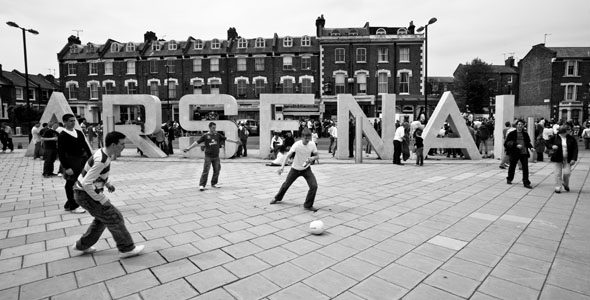Successfully Activating Sporting Sponsorships – Nicholas Reynolds, Populous
May 15, 2015
The Telegraph Business of Sport conference saw some of the biggest brands in the UK come together to discuss the future of business in sport. Here, Nicholas Reynolds, Populous Director and Founder of their in-house brand activation agency Activate, reflects on a panel exploring the activation of sporting partnerships.
It isn’t often that you see a panel that brings together leading figures from the automotive industry, banks, mobile networks and business communication, and This Telegraph Business of Sport panel has given us some real insight into the future direction of sporting sponsorships, what the latest trends are, and what role digital offerings can play today and into the future.
The discussion started at the end, in some ways, with thoughts on the role of measurement in major campaigns.
The consensus was that measuring campaigns today are not the exact science that everyone would like them to be and typically were comprised of ‘tangibles’ assessed by standard metrics and ‘intangibles’, activation opportunities which drove value in other areas of the business.
Every sponsorship campaign will have a potential internal activation to be explored and developed, which, while more difficult to assign a numerical value, must not be underestimated in terms of the positive impact on the rights purchaser’s business.
Of course, at its most simple, the key to successful activation lies in understanding who your customer is. Mark Cameron, Global Experiential Marketing Director at Jaguar Land Rover, cited the example of a Land Rover campaign for the 2015 Rugby World Cup, in which children from around the world will be given the opportunity to be team mascots during the championships.
The aim of this activation is to develop a deep connection with grassroots rugby, a group and demographic that represents a key component in Land Rovers’ customer base.
Perhaps the most interesting feature of this campaign is that each mascot will be able to wear their local rugby club’s socks, creating an emotional connection between the local and global stages for rugby and the company’s customer base.
This example seems to be indicative of a much larger trend away from the days of ‘off-the-shelf’ sponsorship packages. Nathan Homer, Head of Global Sponsorship & Partnerships at Barclays, highlighted the fact that sponsorship opportunities today need to be both bespoke and reciprocal.
This narrative echoes our core driver at Populous Activate, and the platform upon which we established the creative agency; namely the desire to tailor bespoke sponsorship activation opportunities to prospective brands in the sport and entertainment world. Working throughout the creative process with both right holders and brands to create meaningful and powerful activation.
According to Nathan, Barclays received over 9,300 direct sponsorship requests last year, many of which were generic and mass-mailed, and took up only a tiny percentage, preferring to focus on a core of key relationships, rather than a multitude of smaller, surface-level deals.
Our creative work, on behalf of clubs such as Arsenal and Manchester City, or brands such as O2, Emirates and Cadburys, always seeks to unlock the hidden opportunity, harnessing both architecture and event experience to create really meaningful and memorable fan (customer) engagement, integrating identity into design, rather than merely adding it on as an afterthought.
Once again, the panel seemed united in their belief that the best sponsorship opportunities need to be ‘found’ in the search for ‘true’ partnerships; even classic assets are only really optimised when their activation is reinvented in innovative ways, and with digital offerings at their core. Gareth Griffiths, Head of Sports Sponsorship at O2, discussed his team’s use of Oculus Rift to enable customers to train virtually with the England rugby team.
Innovation lies at the core of successful partnerships. O2’s long standing relationship with the England rugby team was presented with a challenge for the upcoming 2015 RWC where their sponsorship is not allowed on the team shirts.
Through their ‘Wear the Rose’ campaign, O2 encouraged fans to pull behind the England team, with the ultimate objective being to replace the 15 (non-O2 branded) shirt wearing players with 80,000 replica England O2 branded shirt wearing fan ambassadors.
As Nathan Homer concluded, the goal with any rights deal is to find the ‘sweet spot’ – that point where, in addition to a straight collateral transition, added value is gained by both parties through brand association. This leads to deep partnerships that produce engaging and connected message to customers.
The consensus from the panel was that approaches by rights holders need to demonstrate a real understanding of the sponsors’ business and values.
Direct approaches with images of photoshopped logos have little impact in an era of constant communication and interaction. Sponsors do not want – or need – to see what their logo looks like on an asset. Rather, they want to understand where the value in the relationship lies and see a bespoke approach to that activation.
 Nicholas is a Senior Principal and a Director of the London office of Populous. He has worked on a diverse portfolio of innovative designs around the world, including sensitive refurbishments of Wimbledon All England Lawn Tennis Club, new performance venues in Shanghai, Abu Dhabi and Copenhagen, and large sports masterplans in the Middle East.
Nicholas is a Senior Principal and a Director of the London office of Populous. He has worked on a diverse portfolio of innovative designs around the world, including sensitive refurbishments of Wimbledon All England Lawn Tennis Club, new performance venues in Shanghai, Abu Dhabi and Copenhagen, and large sports masterplans in the Middle East.
Nicholas was Design Principal for the O2 Arena, a revolutionary scheme involving the construction of a 26,000 capacity arena within the Millennium Dome in London, which was also the first major commission undertaken by Populous Activate, the design studio responsible for the Brand Activation of Populous projects and their sponsors. Nicholas founded Activate to seamlessly integrate partner brands into the design of stadia.



